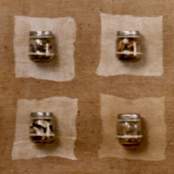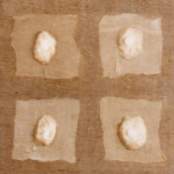
| 
|




| 
| 
| 
| 
| 
|
Mohamed Ghazal is one of many young artists who tend to defy the academic art world. Though the influence of the contemporary 'Germanic' art culture is unmistakable, and though similar creations have been seen hundreds of times from tens of artists who belong to different art cultures, one must give Ghazal for the excellent execution and finishing of his works.
Ghazal exhibits a series of four big square surfaces, each with 25 small square pieces of gauze glued symmetrically on the big mother square. Each small square has an ornament attached to it.
The infinite repetition in each piece raises many mathematical, cultural and aesthetic issues. Repetition as a concept belongs to many old cultures, and was fundamental in Islamic, Coptic, and even pharaonic art. The exhibited works are far from that; each of the stuck ornaments is a product of a civilization on its way to perish. Twenty-five jars full of cigarette butts - what can that mean except that 'all humanity's cigarettes are gone', and there's absolutely nothing more left to offer but leftovers? Leftovers of feelings, sensations and perceptions. The other 75 small squares evoke the same visual puzzles. The perfectly neat work, with its debris of burnt cotton, cigarette butts, stones, spark plugs, etc. defies all pre-set rules and laws of aestheticism, yet the impact is convincing and intelligent.
Khaled Hafez
The Middle East Times | 
| 
| 
| 
| 
|
| 
| 
|

